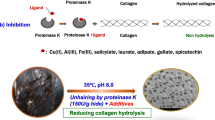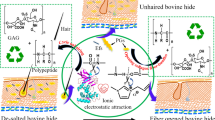Abstract
In this work is described the isolation of a new proteases-producing strain of Bacillus subtilis, screened from aerobic tannery sludge, to be applied in leather production. The optimization of culture conditions to enhance the proteolytic activity was carried out using central composite design. The enzymatic extract was characterized and the hide unhairing and the inter-fibrillary removal capabilities of the enzymatic extract were evaluated by scanning electron microscopy and by the determination of proteoglycans and glycosaminoglycans. The leather quality obtained with this enzymatic preparation was assessed for possible damages to hide collagen by measuring the amount of hydroxyproline released into the reaction medium. Temperature was the most significant factor for culture conditions optimization. The crude enzymatic extract showed the best values for proteolytic activities at pH 9 and 10, temperature between 37 and 55 °C, and showed good thermal stability up to 45 °C. The treated hides presented few remaining hairs; for the enzymatic process, the removal of inter-fibrillary proteins was approximately fourfold for glycosaminoglycans and sixfold for proteoglycans, when compared with the conventional unhairing process. The enzyme application was successful for hide treatment, suggesting that this enzymatic preparation can be used in an environment-friendly leather production to replace the conventional chemical process.




Similar content being viewed by others
References
Cooper M, Gutterres M, Marcílio NR (2011) Environmental developments and researches in Brazilian leather sector. JSLTC 95:243–249
Gutterres M, Aquim PM, Passos JB, Trierweiler JO (2010) Water reuse in tannery beamhouse process. J Clean Prod 18:1545–1552
Sreeram KJ, Ramasami T (2003) Sustaining tanning process through conservation, recovery and better utilization of chromium. Resour Conserv Recycl 38:185–212
Saravanabhavan S, Thanikaivelan P, Rao JR, Nair UB, Ramasani T (2004) Natural leathers from natural materials: progressing toward a new area in leather processing. Environ Sci Technol 38:871–879
Castiello D, Puccini M, Seggiani M, Vitolo S, Zammori F (2008) Lyfe cycle assessment (LCA) of the oxidative unhairing process by hydrogen peroxide. JALCA 103:1–6
Marsal A, Cot J, Bartoli E, Bosch T, Manich A (2001) Oxidising unhairing process with air recovery. JSLTC 86:30–33
Dettmer A, Nunes KGP, Gutterres M, Marcílio NR (2010) Obtaining sodium chromate from ash produced by thermal treatment of leather wastes. Chem Eng J 160:8–12
Dettmer A, Nunes KGP, Gutterres M, Marcílio NR (2010) Production of basic chromium sulfate by using recovered chromium from ashes of thermally treated leather. J Hazard Mater 176:710–714
Wenzel BM, Marcílio NR, Godinho M, Masotti L, Martins CB (2010) Iron and chromium sulfates from ferrochromium alloy for tanning. Chem Eng J 165:17–25
Li S, Li J, Yi J, Shan Z (2010) Cleaner beam house processes trial on cattle sofa leather. J Clean Prod 18:471–477
Jian S, Wenyi T, Wuyong C (2008) Ultrasound-accelerated enzymatic hydrolysis of solid leather waste. J Clean Prod 16:591–597
Kanth SV, Venba R, Madhan B, Chandrababu NK, Sadulla S (2009) Cleaner tanning practices for tannery pollution abatement: role of enzymes in eco-friendly vegetable tanning. J Clear Prod 17:507–515
Bajza Z, Vrcek V (2001) Thermal and enzymatic recovering of proteins from untanned leather waste. Waste Manage 21:79–84
Aquim PM, Gutterres M, Trierweiler JO (2010) Assessment of water management in tanneries: State of Rio Grande do Sul case study. JSLTC 94:253–258
UNEP/IE. (1996) Cleaner production in leather tanning, a workbook for trainers. 1a edn. United Nations, IV3-23
Dettmer A, Cavalli É, Gutterres M, Ayub MAZ (2012) Optimization of biotechnological process for hide unhairing in substitution of toxic sulfides. Chem Eng Technol. doi:10.1002/ceat.201100350
Pillai P, Archana G (2008) Hide depilation and feather disintegration studies with keratinolytic serine protease from a novel Bacillus subtilis isolate. Appl Microbiol Biotechnol 78:643–650
Madhan B, Dineshkumar M, Rao JR, Nair BU (2010) Studies on the removal of inter-fibrillary materials part I: removal of protein, proteoglycan and glycosoaminoglycans from conventional beamhouse process. JALCA 105:145–149
Oskouie SFG, Tabandeh F, Yakhchali B, Eftekhar F (2008) Response surface optimization of medium composition for alkaline protease production by Bacillus clausii. Biochem Eng J 39:37–42
Chauhan B, Gupta R (2004) Application of statistical experimental design for optimization of alkaline protease production from Bacillus sp. RGR-14. Process Biochem 39:2115–2122
Farag AM, Hassan MA (2004) Purification, characterization and immobilization of a keratinase from Aspergillus oryzae. Enzyme Microb Technol 34:85–93
Wan MY, Wang HY, Zhang YZ (2009) Substrate specificity and thermostability of the dehairing alkaline protease from Bacillus pumilis. Appl Biochem Biotechnol 159:394–403
Riffel A, Brandelli A, Bellato CM, Souza GHMF, Eberlin MN, Tavares FCA (2007) Purification and characterization of a keratinolytic metalloprotease from Chryseobacterium sp. kr6. J Biotechnol 128:693–703
Jian S, Wenyi T, Wuyong C (2011) Kinetics of enzymatic unhairing by protease in leather industry. J Clean Prod 19:325–331
Acknowledgments
The authors wish to thank CAPES and CNPq (Project # 505822/2008-3) Brazilian agencies for scientific research and development for their financial support of this study.
Author information
Authors and Affiliations
Corresponding authors
Rights and permissions
About this article
Cite this article
Dettmer, A., Cavalli, É., Ayub, M.A.Z. et al. Optimization of the unhairing leather processing with enzymes and the evaluation of inter-fibrillary proteins removal: an environment-friendly alternative. Bioprocess Biosyst Eng 35, 1317–1324 (2012). https://doi.org/10.1007/s00449-012-0719-z
Received:
Accepted:
Published:
Issue Date:
DOI: https://doi.org/10.1007/s00449-012-0719-z




